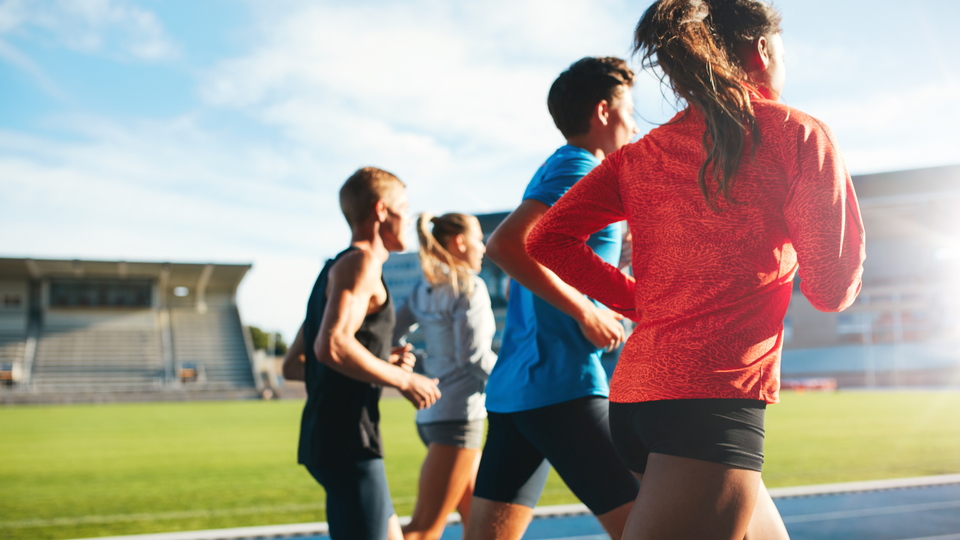Long Term Athletic Development

Written by Jacob Sanders, Sanford Sports, Health: Bismarck, ND
The Long-Term Athletic Development (LTAD) model was created in 1990 by Canadian sports scientist Istvan Bayli, who was a part of the British Amateur Swimming Association. His idea was to create a model to be used by other coaches to facilitate the development of athletes over an extended period of time. This model allows athletes to develop the skills necessary to not only compete in sport,
but to also become lifelong movers. The original model consisted of three stages which included training to train, training to compete, and training to win. It was eventually expanded upon into 7 stages, with Athletics Canada including 9 stages. This article will include the 7-stage model, as it is the one most commonly used.
As coaches we understand that development takes time, and it is important to expose young athletes to a wide variety of movements and skills to help them build confidence for training in the future. It may take anywhere from 8-12 years for an athlete to reach an elite level of performance if they choose to continue participating in athletics. Although pursuing a career in sport may not be the goal
for everyone that we have the opportunity to work with, it is still important that a slower approach is taken in order to allow athletes to have the best chance of success. Due to the amount of time it takes for athletes to mature, it is in their best interest for us to teach fundamental motor skills when they are young. For example, it takes many more repetitions to fix a faulty movement pattern than it does to teach it correctly the first time. Also, if advancements are made too quickly, there will be nowhere to progress.
At the most basic level, our goal in training is to elicit adaptations and build upon skills over time. This is where the model allows us to take an approach most beneficial to the athlete long term. We understand that athletes mature physically at different times, and that their chronological age does not always coincide with their biological age. This is further expanded when taking their training age into
account. On top of these factors, the ages where different qualities can be trained to the greatest degree differ between males and females. Females tend to mature at a faster rate; therefore, they typically see a faster progression in athletic advancement. Because of this, the LTAD model argues that there are critical periods of time where training a specific quality will have the greatest effect, therefore, the model takes these times and ages into account allowing the coach to have a sustainable framework to work from. These qualities include endurance/stamina, strength, speed, skill, and suppleness. The endurance window is said to be during the onset of peak height velocity (PHV), or when the individual
experiences the fastest upward growth in their stature. The strength window occurs immediately after PHV while speed has 2 separate windows. The first being 7-9 years of age and 6-8 years for boys and girls respectively. The second window for boys is from ages 13-16 and 11-13 for girls. Skill development is 9-12 years for boys and 8-11 for girls with suppleness being from 6-10 years for both boys and girls.
Stage 1: Active Start. Ages 0-6
The active start stage is a time which allows young kids to move around and learn to be active. There is little to no coaching involved during these times as the kids should be encouraged to explore new movements while discovering patterns on their own that promote movement problem solving. It is important to make this fun, so the child can learn to make movement a habit throughout their lifetime.
There are no specific qualities that are trying to be developed during this stage, and general movement is key.
Stage 2: FUNdamentals. Ages 6-9 (males) 6-8 (females)
This is the time to develop fundamental motor skills such as running, jumping, kicking, throwing, catching etc.... During this stage, the athletes should begin to work on skills such as agility, balance, and coordination. There is still no formal training during this period, however, the goal of them being active does become more specific to work on the aforementioned skills. This stage should be a natural
progression from general movement into the teaching of fundamental motor skills so that they are engrained earlier rather than later. There should be an emphasis on flexibility during this period which allows for the athlete to be more successful in later stages that may require strength in larger ranges of motion. It is important that this is continually trained later in their career as if you don’t use it, you wil lose it. Gymnastics would be a great example of what this stage is attempting to accomplish. The athlete must learn to use their body in a way that increases movement quality, flexibility, and overall relative strength.
Stage 3: Learning to Train. Males 9-12/Females 8-11
Stage 3 is a time where young athletes can continue to develop agility, balance, and
coordination. General strength development should occur during this time, with how it looks being up to the coach’s discretion. It may be bodyweight exercises or movement training with very light weights that the athlete is able to handle for many reps. Working sub maximally will allow more reps to be completed which will further engrain movement patterns while still developing strength. Because they are maturing, and the stimulus is novel to them they will become stronger regardless of what is used for strength development. It is still important to train flexibility along with general aerobic fitness as this is the time where the body is best able to adapt to longer endurance. Although training may not be completely formal at this point, it is a great time to teach the athlete what training is, and the importance of doing so. As they begin to age, they still may not completely care about why they are training or what they are training for, but having a simple explanation for what they are doing and why may help them to understand the importance of it as they mature.
Stage 4: Training to Train. Males 12-16/Females 11-15
The theme with this model is that the previous stage allows for further development onto later stages. Stage 3 should allow a bigger base to be built with some strength and aerobic fitness which will then in turn create success when more specific work is trained during stage 4. This stage is when the athlete should continue to train endurance, strength, and begin to focus on speed. At this time, young athletes have a pliable nervous system, letting them adapt very quickly to whatever is thrown at them. Because of this, athletes should be sprinting often. Due to their physical output not being as high as it will be later in their training career, sprinting frequency can be very high. Their effort will be maximal,
yet their body is not truly working at 100 percent which is why they are able to train speed with more frequency than a well-trained athlete. Formal weight training that is planned can now be introduced into the athlete’s schedule, with a gradual approach to progression being taken. This is also the time where athletes should include some specific skill work pertaining to their sport. Ideally the athlete will be participating in several sports which results in specific qualities needed to be developed just by practicing the sport itself.
Stage 5: Training To Compete Males 18-21+/Females 17-21+
Training to compete is now the time where athletes may begin to pick one sport to focus on, with an increase in sport specific preparation. As mentioned previously, it is important that the athlete participates in several activities before this point as early specialization rarely results in success later in their career. Staying active or competing in numerous activities before this point will only be beneficial for the athletes overall athletic development. As an example, 90 percent of NFL athletes participated in multiple sports during their high school career. During this stage we can increase the number of training sessions per week which the athlete should be able to handle well if they were developed from an early age. During this time, the athletes may be graduating from high school and transitioning into collegiate
athletics. For athletes that are not participating in sports while in college, they should focus on continuing to stay active for life. This could mean training on their own or being involved in recreational sports.
Stage 6: Training to Win. Males 20-23+/Females 20-23+
Training to win is the period where the athlete is competing collegiately or professionally. Most athletes will not compete at the college level, and even less will make it to the professional level. At this point, they are full time athletes, and are working to maximize specific performance. It becomes even more rare to play multiple sports in college, so this is a great time for further specialization of training tailored for the needs of whatever they are participating in. Up to this stage, the individual should have a very strong grasp of the training process and understand the work that it takes to excel at the next level. While their training is now geared towards the sport they compete in, it is still important to emphasize movement quality. Coaches should still include general strength training while still having the opportunity to maintain and improve qualities such as strength, endurance, suppleness, speed and skill.
Stage 7: Active For Life
Stage 7 is the final stage of the model and will be the last step for all individuals. Some athletes may skip stages 5 and 6, however all athletes will come to this point once their athletic career is over. Continuing to pursue an active lifestyle is the final goal of the model. This could look different for everyone as some may continue to stay involved in some form of athletics, while others may continue
to train for general health and wellness. Ideally, the individual should have a strong base to build from if the groundwork was laid correctly before reaching this point. This stage will continue for the rest of their life, and if the previous stages were worked through in a well-planned manner, they should be able to enjoy continuing to work on personal health and wellness goals. There is no one way to develop athletes, and every coach’s situation differs whether it be the kids they work with or the equipment available to them. If there is a plan that sticks with principles that work and the athletes are engaged in their training, progress will be seen long term. There is plenty of time for an athlete to develop if they are active from an early age, and the process should not be rushed. Although the LTAD model does not give specific exercises, sets, reps, or intensities, it does allow the coach to have a guided long-term plan which promotes freedom to program for any athletes they engage with.

Member discussion